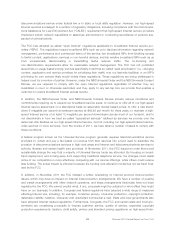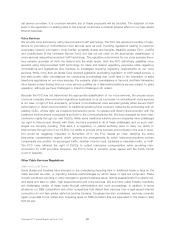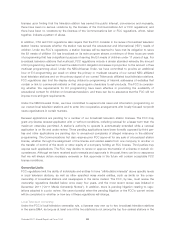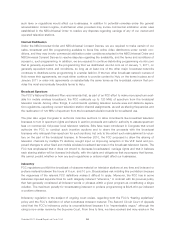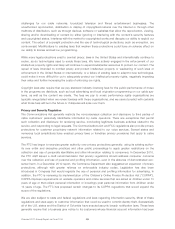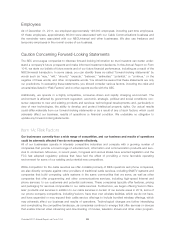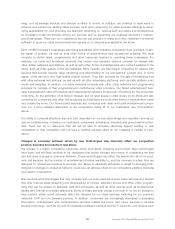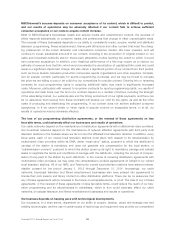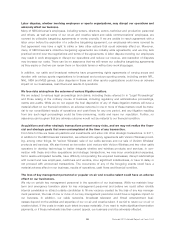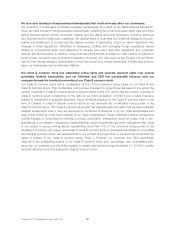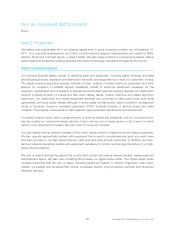Comcast 2011 Annual Report Download - page 31
Download and view the complete annual report
Please find page 31 of the 2011 Comcast annual report below. You can navigate through the pages in the report by either clicking on the pages listed below, or by using the keyword search tool below to find specific information within the annual report.ming, and as wireless services and devices continue to evolve. In addition, we continue to seek ways to
enhance and expand our existing cable services, such as by enhancing our video services offerings by devel-
oping applications for, and providing live television streaming on, devices such as tablets and smartphones,
by increasing cross functionality among our services and by expanding our business services to medium-
sized businesses. There can be no assurance that we can execute on these and other initiatives in a manner
sufficient to grow our cable communications business or to compete successfully in the future.
Each of NBCUniversal’s businesses also faces substantial and increasing competition from providers of sim-
ilar types of content, as well as from other forms of entertainment and recreational activities. We must
compete to obtain talent, programming and other resources required in operating these businesses. For
example, our cable and broadcast networks and owned local television stations compete for viewers with
other similar networks and stations, as well as with other forms of entertainment and content available in the
home, such as video games, DVDs and websites. More recently, we have begun competing for viewers with
services that provide Internet video streaming and downloading of our competitors’ content and, in some
cases, of the service’s own high-quality original content. They also compete for the sale of advertising time
with other networks and stations, as well as with all other advertising platforms, such as radio stations, print
media and websites. In addition, our cable networks compete with other cable networks and programming
providers for carriage of their programming by multichannel video providers. Our filmed entertainment busi-
ness competes with other film studios and independent producers for sources of financing for the production
of its films, for the exhibition of its films in theaters and for shelf space in retail stores for its DVDs and also
competes for consumers with other film producers and distributors and all other forms of entertainment inside
and outside the home. Our theme parks business also competes with other multi-park entertainment compa-
nies. For a more detailed description of the competition facing all of our businesses, see “Competition”
above.
Our ability to compete effectively also is in part dependent on our perceived image and reputation among our
various constituencies, including our customers, consumers, advertisers, investors and governmental author-
ities. There can be no assurance that we will be able to compete effectively against existing or new
competitors or that competition will not have a material adverse effect on our business or results of oper-
ations.
Changes in consumer behavior driven by new technologies may adversely affect our competitive
position, business and results of operations.
We operate in a highly competitive, consumer-driven and rapidly changing environment. New technologies
have been, and will likely continue to be, developed that further increase the number of competitors we face
and that drive changes in consumer behavior. These technologies may affect the demand for all of our prod-
ucts and services, as the number of entertainment choices available to, and the manners in which they are
delivered to, consumers continue to increase. Our failure to effectively anticipate or adapt to emerging tech-
nologies or changes in consumer behavior could have an adverse effect on our competitive position, business
and results of operations.
New services and technologies that may compete with our video services include online services and devices
that offer Internet video streaming and downloading of movies, television shows and other video program-
ming that can be viewed on television sets and computers, as well as other devices such as smartphones,
tablets and Internet-connected televisions. Some of these services charge a nominal or no fee for access to
their content, which could adversely affect the demand for our video services, including for our premium
networks, DVR and On Demand services. In addition, consumers are increasingly interested in accessing
information, entertainment and communication services outside the home, and newer services in wireless
Internet technology, such as 3G and 4G wireless broadband services and Wi-Fi networks, and devices such
29 Comcast 2011 Annual Report on Form 10-K


